The first six weeks of school are, in many ways, the most critical of the year. For schools that use the Responsive Classroom approach, like Friends School of Portland, those precious weeks are when we lay the foundation for classroom communities that will honor, challenge, and support each member throughout the year. Some teachers talk about this as “going slow to go fast.” We take our time during September and October to build the social-emotional-behavioral groundwork for the year ahead; playing get-to-know-you games; co-creating classroom expectations and rules; and practicing what it looks, sounds, and feels like to be part of our classroom community.
As part of our commitment to the ongoing work of moving toward anti-racist practice, we also come to this work with an additional lens. In an equitable classroom community, each student is empowered to bring his/her/their full self to school, to be recognized and supported and loved, and to have voice and agency in the community. This kind of community is built on daily work in which students explore their identities and practice speaking their truths (and listening to others!). This work is also foundational to our work as a Friends School-- it is a way of recognizing the light within each student and facilitating a community that recognizes and cherishes the light within each. It is on this foundation, also, that we can begin to build an understanding of a more just world and of our roles in shaping it. Below are excerpts from teachers’ weekly emails home to parents that provide windows into what this work looks like in some of our classrooms:
Lindsay’s 3rd and 4th Grade Class
“Our work at building an anti-bias, anti-racist community is ongoing and emergent. The first step is building a sense of identity. We work at answering the questions "Who am I?", "What is my role in this community?", and "How are we alike and different?". We do this work by sharing our hopes and dreams and creating rules as a group that keep us safe and accountable...This week we explored aspects of identity including our names, race and ethnicity, physical characteristics, and more through reading and writing poetry... To accompany our poems, students are creating “Inside Out Self Portraits”. One side of the portrait is their outer self which is visible to the world. On the other half is their inner self, and aspects of their identity that are not immediately visible.”
Ashley’s and Jonathan’s Preschool Class
“As we wandered into the forest space, we stopped to sit on a log named Jimmy (this log looks like a dinosaur, and last year the preschoolers named it Jimmy!) At this moment, students had some very strong feelings about where to sit, and how to sit, and when to sit. These feelings did not match others’ feelings about this activity. This teachable moment turned into a strong, emerging opportunity to really practice our social skills through peer negotiation and conflict resolution.
For preschool, and really at any age, it can be very tricky to navigate a situation when friends have a different plan than other friends. It can also be very difficult to use our words when we are feeling strong feelings, and this moment in the woods allowed the teachers to facilitate some really great learning around that...That is why we spend so much time giving space for each friend to be heard and to give each friend the space to feel their feelings.”
Allie and Aliza’s 5th and 6th Grade Classes
“This week students worked on a piece of writing that asked them to consider their own identity. The piece used an excerpt from The Terrible Two by Mac Barnett and Jory John as inspiration. Here are some lines from student work,[combined into a class poem]:
I’m the kind of kid who comes out to lunch hysterically screaming.
The kid who never climbs to the top of the monkey bars even when people tell him to
The kid who could talk about Star Wars for hours
The kid who hates to not get an inside joke.
The kid who is always daydreaming even if she looks like she’s paying attention, and the kid who is always paying attention even if she looks like she’s daydreaming.
Talk so much I lose my voice at the end of the day kind of kid.
The kid who loves to make friends
The kid who wants to be the best that he can.
The kid with the bone-crushing hugs.”

